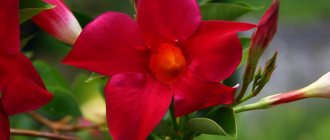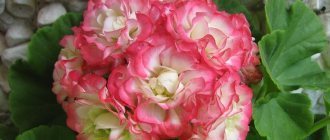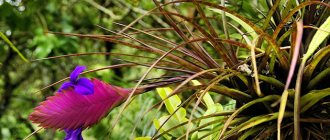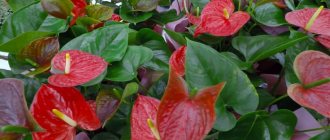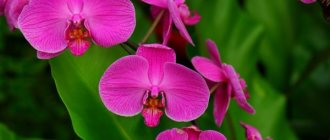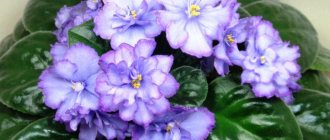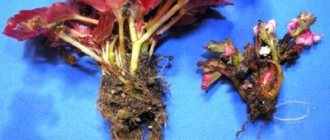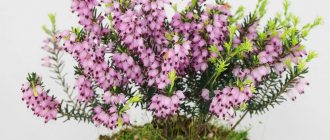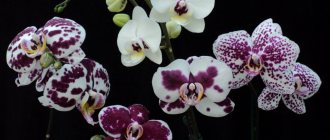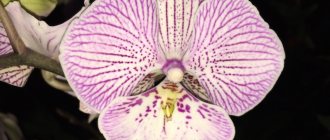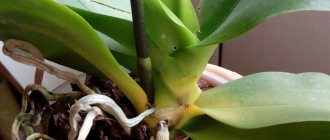Author: Elena N. https://floristics.info/ru/index.php?option=com_contact&view=contact&id=19 Category: Houseplants Published: February 25, 2018Last edits: January 11, 2021
- Growing from seeds
- Dipladenia leaves turn yellow
- Dipladenia splendens
Dipladenia, or mandevilla (lat. Mandevilla) is a genus of flowering climbing plants of the Kutrovaceae family, which can be found in nature in South and Central America. The genus includes, according to various sources, from 120 to 190 annual and perennial species. In everyday life, garden, greenhouse and home dipladenia are sometimes called Brazilian balsam or jasmine, Chilean jasmine, Mexican tree of love and Bolivian rose. The scientific name "Mandevilla" was given to plants of the genus in honor of the English diplomat and amateur gardener Henry J. Mandeville, who was serving in Argentina at that time. “Dipladenia” is translated from Greek as “having double glands.” Mandevilla at home is a very beautiful plant, but it is demanding on conditions and capricious to care for, but despite this, it is gaining more and more popularity in indoor culture every year.
Guest from South America - dipladenia
Dipladenia, or as it is also called mandevilla, is a decorative deciduous evergreen vine. It is still rarely seen in the collections of Russian amateur flower growers, but in vain. A compact vine with glossy bright green leaves is a real decoration for any interior. Dipladenia blooms almost all summer. Flowers measuring 10–12 cm are beautiful and fragrant.
In natural habitats there are real jungles of Dipladenia
The liana grows in the humid tropics of Brazil, Mexico, Bolivia and other countries in South and Central America.
The flower has two names - dipladenia and mandevilla. The first plants found in the forests of the South American continent were called Dipladenia. Later, other species of Dipladenia were discovered, but they were mistakenly classified as a separate genus, which received the name Mandeville, in honor of Sir Henry Mandeville, an English diplomat and gardener. And both names are still in use.
The liana has two names: Dipladenia and Mandevilla.
Dipladenia is a perennial with shiny, leathery leaves ending in a characteristic pointed tip. The plant has a tuberous rhizome.
Among the people, the liana has received several romantic names: it is called the Mexican tree of love and Bolivian rose, Chilean jasmine and Brazilian balsam.
Brazilian balsam flowers have a variety of colors - from snow-white to cherry-red. Some types of dipladenia have a very delicate aroma and bloom for a long time from May to the end of autumn, with each flower pleasing others with its beauty for about 10–12 days.
Dipladenia can grow exclusively in tropical climates. In our country, it is grown in greenhouse or indoor conditions. The flower is poisonous, all its parts contain dangerous substances, so it is not recommended to grow it where there are small children. When caring for Dipladenia, you must also be careful and wear gloves when carrying out pruning, watering and other procedures.
From red to white: description of types and varieties of domestic mandevilla with photos
The genus Dipladenia has up to 40 species, but only a few of them are grown in captivity. Adapted best to indoor conditions:
- Dipladenia brilliantis is an ampelous plant with pubescent shoots reaching three meters in length. The leaf blades are about 20 cm in size. A network of veins appears on the surface. The buds are bright pink with purple bracts. There are 5–6 flowers in the raceme;
- Dipladenia superb is an incredibly graceful plant with slightly pubescent thin shoots and small leaves. Large flowers are painted in different shades of pink with bright red bracts and are collected 6-8 pieces in racemes;
- Dipladenia sandera is a beautiful liana with green pointed leaves, in the axils of which there are soft pink flowers about 8 cm in diameter with a yellow throat;
- Dipladenia Bolivianum is a plant with glossy small leaves and smooth stems. The liana blooms with white fragrant flowers, the diameter of which is 5 cm;
- Dipladenia friable is a powerful plant with warty shoots that naturally grow up to 6–7 meters. The leaves are colored gray-green. The flowers are snow-white or cream up to 5 cm in diameter. They emit a pleasant aroma.
Not only species of Dipladenia are grown indoors, but also numerous varieties, among which are:
- Allmand and Yellow, the flowers of which are painted in yellow shades;
- Cosmos White with snow-white large buds;
- Cosmos Pink, the flowers of which have a pinkish tone with a yellow throat;
- Cosmos Rose with double flowers;
- Classic Red, Cosmos Crimson King with gorgeous red flowers.
Photo gallery: Mandevilla splendor and other natural species
Dipladeniya brilliantis - ampelous plant with pink flowers
Snow-white flowers bloom on Dipladenia boliviana
Flowering of Dipladenia loose lasts six months
Dipladenia sandera - graceful vine with bright pink flowers
Dipladenia superb has small leaves
The work of breeders: dipladenia with yellow and double flowers in the photo
The Yellow variety is distinguished by large bright yellow inflorescences
Dipladenia variety Almand is strewn with fragrant yellow flowers
Dipladenia variety Classic Red has an original color: bright red petals are decorated with white stripes
Dipladenia flowers of the Cosmos Pink variety are pink in color and have a yellow throat
Cosmos Rose - variety with double flowers
Bloom
The plant blooms quickly, already in the first season of vegetative development. At first, these are single buds that form at the ends of young shoots. Gradually the flowering becomes more luxuriant. Each flower lives for about 10 days, after which a new one opens to replace it. They are large in size, their diameter reaches 12 cm.
In appearance, the flowers resemble an open funnel of bright pure color - pink, snow-white, yellow, orange, crimson, red. The petals are separated from each other and have a lanceolate shape. Dipladenia flowers have a sweet aroma of pronounced intensity.
Table: conditions required for indoor liana
| Season | Lighting | Humidity | Content temperature |
| Spring Summer | Dipladenia is photophilous, but does not like direct sunlight. In summer, it is best to take the pot with the vine to the balcony. In the room, the ideal option would be to place it on an east-facing window. | Humidity is high. In hot weather, daily spraying with warm water is necessary. | +22–25°C |
| Autumn winter | Requires a very bright place and additional illumination with fluorescent lamps | Humidity 40–60%. It is advisable to place a household humidifier or a cup of water next to the vine | +15–17 °C |
Temperature
During the spring-summer season, the most comfortable temperature for the plant will be 25 °C or higher. In winter, it is recommended to maintain it at 15 °C.
In summer it is important to provide the flower with ventilation. To do this, they take it out onto the balcony or place it next to the house, if possible. It must be remembered that the sun's rays falling on the leaves can cause burns. Therefore, at such times it is important to provide shade for the plant.
If dipladenia grows in an apartment, it needs regular ventilation. In this case, it is necessary to exclude the possibility of drafts.
Heat plays an important role in caring for the Dipladenia flower. The more it is, the juicier and brighter the flowers, the more actively this vine develops.
Since the daylight hours are much shorter in winter, the plant begins to go dormant. At this time, a lower temperature will be required for its comfortable existence. However, care must be taken that the air temperature does not fall below 13 °C.
Recommendations for caring for mandevilla
To successfully grow a tropical beauty, it needs good care. The flower must be protected from drafts and provided with regular watering, spraying and fertilizing.
Watering with acidic water
Dipladenia, like all other tropical plants, needs abundant watering with warm water, but waterlogging should not be allowed, since stagnation of moisture can lead to rotting of the roots. In summer, the vine is watered every 2-3 days after the top layer of soil in the pot has dried. In winter, the number and volume of watering should be reduced.
In order for dipladeniya to bloom magnificently, it needs to be provided with abundant moisture.
It is recommended to acidify the water. To do this, add a little acetic or citric acid to the liquid. It is not difficult to check the degree of acidification; just taste it; the water should be slightly sour.
If acetic acid is used to acidify water, the liquid must stand in an open container so that the characteristic odor evaporates from it.
You need to constantly humidify the air
Brazilian balsam requires moist air. The plant must be frequently sprayed with warm water or installed next to the vine with a humidifier, a plate with wet pebbles, or an indoor fountain.
Necessary feeding
Since Dipladenia blooms profusely and for a long time, it requires a lot of nutrients. Fertilize the vine in the spring-summer period once every 2 weeks with complex mineral fertilizer for beautifully flowering plants. The drug Kemira Lux is perfect for this purpose.
Kemira Lux is a mineral fertilizer with a wide range of applications
The solution is made according to the instructions and applied to the soil 30 minutes after watering. In October, feeding is completely stopped.
Flowering period
In its natural environment, the liana can bloom all year round. “In captivity”, due to the reduction in daylight hours, mandevilla goes into a state of forced suspension of development and blooms again only in April-May.
Dipladenia blooms continuously for six months
The flowering period lasts six months, while buds are constantly formed. To prevent the plant from wasting extra energy, faded flowers must be periodically removed.
What to do in winter during the dormant period
For successful wintering, you need to prune the dipladenia at the end of October, leaving about 1/3 of the shoots on the plant. The liana is placed in a cool place with a temperature of +15–17 °C. Please note that the southern woman cannot tolerate temperatures below +12 °C. Hypothermia of the earthen clod is very dangerous, so it is recommended to place the pot with the vine in a wooden pot during the winter.
Watering in the fall is reduced. It is enough to moisten the earthen ball once a week. Feeding is canceled completely .
Correct cutting and shaping
Pruning mandevilla is a necessary technique that ensures abundant flowering, since buds form only on annual side shoots.
If you want a lush flowering plant, don’t be afraid to trim and pinch the dipladenia
The procedure is carried out in the fall, shortening all shoots by 2/3. In the spring, when the plant enters the phase of active growth, the tops are pinched for lush branching.
Table: typical problems when growing plants, their causes and solutions
| What does the plant look like? | What is the reason | How to fix the situation |
| the plant sheds buds and leaves |
|
|
| not enough light |
|
| The plant is withering | lack of watering |
|
| Leaf blades turn yellow and fall off | the plant is too hot |
|
List of the most common problems
Flower growers do not always have the opportunity to analyze the situation and deal with the problem that has arisen. Therefore, it is convenient to use the list of the most frequently occurring problems that cause changes in leaf color.
- Low temperature. When there is frost, the leaves of Dipladenia begin to turn yellow and then fall off.
- Insufficient lighting. Dipladenia is a light-loving plant. When there is insufficient light, the color of the leaves becomes lighter, growth slows down, and flowering becomes rare.
- Irrigation failure and dry air. When drought conditions are created, Dipladenia leaves wither and flowers fall off. A similar situation occurs with a shortage of fertilizers.
- Excess sun and dry air. Dipladenia is a light-loving plant, but does not tolerate direct exposure to ultraviolet radiation. Under the scorching rays, the leaves get burned. As a result, they turn yellow, curl and dry out.
- Poor quality soil and excess moisture. As a result of stagnation of water, the root system of Dipladenia rots. The leaf blades become thin, sluggish, and the shade changes to yellow. Gradually the plant dies.
Most problems that cause leaf pigmentation are related to plant care practices. Therefore, the correct selection of location, nutritious soil and timely watering play a big role for the harmonious development of the flower and its abundant and long flowering.
Table: pests and diseases that threaten dipladenia
| Disease or pest | Signs | Methods of disposal |
| Spider mite | The leaves become covered with small brown spots, then turn yellow, dry out and fall off. | If the damage is minor, remove the leaf and wipe the remaining leaves with acidified water and liquid soap. In case of significant damage, treatment with Fitoverm is necessary. |
| Mealybug | Cotton-like coating on leaves and shoots |
|
| Nematode |
|
|
| Powdery mildew | white coating on the upper surface of the leaf |
|
| Root rot |
|
|
Photo gallery: enemies of flowers and leaves - pests and diseases
A sign of powdery mildew is a white coating on the upper surface of the leaf.
Cotton-like growths on shoots and leaves are mealybug colonies
Necrotic spots on leaves are the result of nematode activity
With root rot, mold appears on the root collar
Spider mite. There are more than 40 species of these small mites with a round body of red or red color, which affect almost all plants
What does it mean if leaves turn yellow or fall off?
If mandevilla leaves turn yellow and fall off, it must be urgently isolated from other indoor crops. Such symptoms may indicate a flower disease or pest infestation.
Pests and control methods
Harmful insects such as whiteflies and spider mites cause great harm to the plant. Infestation by these pests can be determined by the following signs:
- Whitefly. It is clearly visible against the background of green leaves. These are small white midges the size of larvae. Whiteflies can infect a flower when airing it outside. All above-ground parts of the plant should be thoroughly washed under running water. If infection cannot be avoided, it is necessary to treat the flower with an insecticidal preparation.
Whitefly - Spider mite. The tick itself is almost impossible to notice, but the product of its activity - a thin web - is clearly visible. As a rule, the mite entangles it on the underside of the leaves and petioles. Spider mites appear in dry air conditions. It can only be eliminated with an insecticide.
Diseases and treatment
Most often, mandevilla is affected by root rot and powdery mildew. Root rot occurs due to waterlogging of the soil and stagnation of moisture in the tray of the pot. The disease manifests itself as yellowing and drying of the leaves and stems of the plant. The buds of the affected flower fall off without opening. The roots of the plant rot. You can get rid of rot in the early stages of its development. First, all affected parts are removed from the plant, then it is treated with a fungicide several times.
Powdery mildew is an equally unpleasant disease. It manifests itself as a white powdery coating, which over time covers the entire surface of the leaves. In the early stages of the disease, experienced gardeners advise wiping the affected leaves with lemon juice. If this does not help, it is necessary to combat the disease with fungicides.
How to propagate Brazilian balsam
Dipladenia propagates in three ways: cuttings, seeds and layering. Each has its own advantages and its own difficulties.
Root the cuttings
Dipladenia is often propagated at home by cuttings. This procedure is carried out in the spring. The stages are as follows:
- Young shoots are cut off from the plant. Each cutting should have 2-3 leaves.
- The cuttings are dipped into a solution of root formation stimulants Zircon, Heteroauxin or Kornevin.
- A mixture of peat and sand is poured into the container.
- The cuttings are planted in the substrate at an angle.
- The soil is moistened.
- The plantings are covered with a transparent lid to create greenhouse conditions and placed in a warm, bright place.
Plantings are covered with transparent covers to ensure greenhouse conditions - The cuttings are regularly watered and ventilated throughout the entire rooting period.
- After about a month, the lid is removed and care for the young plants continues.
About a month after planting, the cuttings take root - After two weeks, they are transplanted into separate pots and placed in a permanent place.
Root cuttings
Dipladenia propagation by layering is a very effective way. For this:
- Bend down a young, unformed shoot and pin it to the ground.
- After some time, roots will appear on it.
- After the roots appear, the new seedling is separated from the mother plant and planted in a separate container.
Try the seed method
Sometimes you can find Dipladenia seeds in specialized stores. For seed germination, it is important to maintain a high air temperature: from + 22 to + 28 degrees.
Seeds germinate only at high humidity and temperature
The seeds are sown in a light, slightly acidic substrate, moistened and covered with film. It can take 2–4 months for seeds to germinate; throughout the entire period, the crops are provided with heat, high humidity and light. After the emergence of seedlings, the film is removed and the seedlings continue to be cared for as adult specimens.
Video: how to propagate a flowering vine
Reproduction
Cuttings
The most popular method of propagating mandevilla is cuttings. Time: spring.
- Select stem or apical cuttings 8-10 cm long. Leave a couple of leaves, carefully pinch off the rest.
- Keep the cuttings in any stimulant (for example, “Kornevin”).
- Pour a mixture of sand and peat into plastic cups and place the cuttings there. It is better not to use water for rooting - cuttings take root in it only in half of the cases.
- Cover the containers with cling film, glass or a regular jar, and place in a warm, sunny place. The temperature for germination should be maintained at +24-26 degrees. Remove the protective layer every day to ventilate and spray the soil.
- As soon as the first shoots appear (after about 1-1.5 months), remove the film, and after another 3 months, transplant the rooted parts into separate pots.
Useful video
From the video you will learn how to properly carry out mandevilla cuttings:
Seeds
Propagation by seeds is somewhat more difficult.
The main problem: how to find quality material? It’s very rare to find it in our flower shops! If you have the opportunity to take seeds from familiar gardeners, take advantage of this opportunity rather than buy. If not: check the quality of the packaging and the sorting date. And remember: seedlings grown from seeds are very fragile and will have to be grown for several years .
- Soak the material in a growth stimulator for a day.
- Plant the seeds 1-2 cm deep into the soil. Moisten the soil, cover the box with film and wait for the sprouts to appear. Care is the same as for cuttings. It is advisable to organize bottom heating. Make sure that condensation does not accumulate on the inner walls of the greenhouse.
- After 4-5 weeks, the first shoots will appear, and very weak ones, which require special attention. The film can be removed. Continue to moisten the soil with a spray bottle, protect the flower from direct sunlight, drafts and precipitation.
- When 2 leaves come out, transplant the sprouts into separate pots with a diameter of no more than 7 cm.
